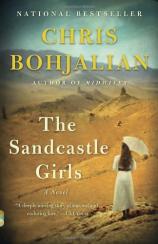Reading Group Guide
Discussion Questions
The Sandcastle Girls

1. Though The Sandcastle Girls is a novel, author Chris Bohjalian (and fictional narrator Laura Petrosian) based their storytelling on meticulous research. What can a novel reveal about history that a memoir or history book cannot? Before reading The Sandcastle Girls, what did you know about the Armenian genocide? How does this history broaden your understanding of current events in the regions surrounding Armenia?
2. What lies at the heart of Armen and Elizabeth’s attraction to each other, despite their seemingly different backgrounds? What gives their love the strength to transcend distance and danger?
3. The novel includes characters such as Dr. Akcam, Helmut, and Orhan, who take great risks opposing the atrocities committed by their superiors; Bohjalian does not cast the “enemy” as uniformly evil. What do these characters tell us about the process of resistance? What separates them from the others, who become capable of horrific, dehumanizing acts?
4. Discuss the bond between Nevart and Hatoun. What do they demonstrate about the traits, and the trauma, of a survivor? How do they redefine motherhood and childhood?
5. Bohjalian is known for creating inventive, authentic narrators for his novels, ranging from a midwife to a foster child. Why was it important for The Sandcastle Girls to be told primarily from the point of view of a woman? How was your reading affected by the knowledge that the author is a man?
6. In chapter 9, Elizabeth courageously quotes the Qur’an to appeal to the conscience of the Turkish lieutenant. What diplomacy lessons are captured in that moment? For the novel’s characters—from aid workers to Armenians who tried to convert—what is the role of religion?
7. When Laura describes the music of her 1960s youth, her steamy relationship with Berk, her belly-dancing aunt, and other cultural memories, what is she saying about the American experience of immigration and assimilation? Culturally, what did her grandfather sacrifice in order to gain security and prosperity in America?
8. Discuss the various aid workers depicted in the novel. What motivated them to assist in this particular cause? Do Alicia, Sister Irmingard, and Elizabeth achieve similar outcomes despite their different approaches? What overseas populations would you be willing to support so courageously?
9. Does Ryan Martin use his power effectively? How does Elizabeth gain power in a time period and culture that was marked by the oppression of women?
10. The vivid scenes of Gallipoli bring to life the global nature of war over the past century.
As Armen fights alongside Australians, what do we learn about the power and the vulnerabilities of multinational forces? What did it mean for his fellow soldiers to fight for a cause so far removed from their own homelands, and for his own countrymen to rely on the mercy of outsiders?
11. At the end of chapter 19, does Elizabeth make the right decision? How would you have reacted in the wake of a similar tragedy?
12. How do Laura’s discoveries enrich her sense of self? Discuss your own heritage and its impact on your identity. How much do you know about your parents’ and grandparents’ upbringing? What immigration stories are part of your own family’s collective memory?
13. As she tries to explain why so few people are aware of the Armenian genocide, Laura cites the fact that the victims perished in a remote desert. The novel also describes the problem of trying to document the atrocities using the cumbersome photography equipment of the day. Will the Information Age spell the end of such cover-ups? For future generations, will genocide be unimaginable?
14. Which aspects of The Sandcastle Girls remind you of previous Bohjalian novels you have enjoyed?
The Sandcastle Girls
- Publication Date: April 16, 2013
- Genres: Fiction, Historical Fiction, Women's Fiction
- Paperback: 320 pages
- Publisher: Vintage
- ISBN-10: 0307743918
- ISBN-13: 9780307743916








